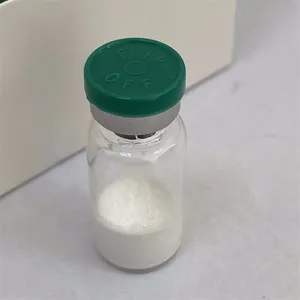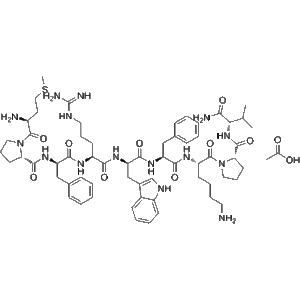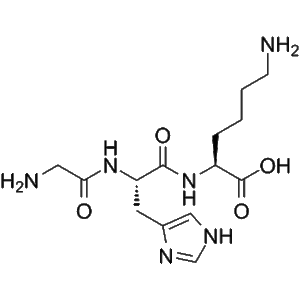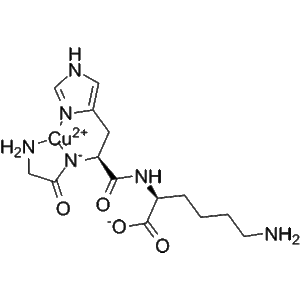No products in the cart.
Sale
Elcatonin (CAS No. 60731-46-6) | Synthetic Analogue of Eel Calcitonin
Original price was: $32.00.$26.00Current price is: $26.00.
Elcatonin (CAS No. 60731-46-6), also known as Carbocalcitonin, is a synthetic analogue of eel calcitonin. It increases bone mineral density, suppresses bone resorption, and has a central analgesic effect. For research use only.
Description
Product Description
Elcatonin (CAS No. 60731-46-6), also known in the literature as Carbocalcitonin, is a synthetic peptide drug modeled after eel calcitonin, a naturally occurring hormone with potent effects on calcium and bone metabolism. Calcitonin itself is secreted by the parafollicular cells (C cells) of the thyroid gland in mammals and plays an important role in maintaining calcium homeostasis by reducing blood calcium levels and inhibiting bone resorption. Eel calcitonin, discovered for its exceptionally strong potency compared to mammalian calcitonin, served as the basis for the development of Elcatonin as a more stable and clinically useful analogue.
The rationale behind the design of Elcatonin was to retain the beneficial anti-resorptive effects of calcitonin while improving stability, half-life, and bioavailability. Natural calcitonin peptides are often limited by enzymatic degradation and relatively short activity durations. By modifying the molecular structure, Elcatonin achieves enhanced resistance to enzymatic breakdown, thereby making it a valuable tool in both research and therapeutic development settings.
Bone Mineral Density and Osteoporosis Research
One of the major research applications of Elcatonin lies in the study of bone metabolism and osteoporosis. Osteoporosis, characterized by reduced bone mineral density (BMD) and increased fragility, results from an imbalance between bone resorption by osteoclasts and bone formation by osteoblasts. By inhibiting osteoclast activity, Elcatonin directly reduces the rate of bone resorption. At the same time, it indirectly promotes the maintenance or increase of BMD, making it a useful agent in the exploration of anti-osteoporotic strategies.
Studies have shown that calcitonin and its analogues like Elcatonin can reduce fracture incidence in animal models by slowing down the loss of bone tissue. Unlike bisphosphonates or selective estrogen receptor modulators (SERMs), which also act on bone metabolism, calcitonin analogues present a different pharmacological pathway that is valuable for comparative and combination research.
Central Analgesic Effects
Interestingly, Elcatonin exhibits not only skeletal effects but also central analgesic properties. Research indicates that calcitonin and its analogues may act on the central nervous system to alleviate certain types of pain, particularly chronic musculoskeletal pain and pain associated with osteoporosis-related fractures. The precise mechanisms underlying this effect remain under investigation, but evidence suggests that Elcatonin may influence neurotransmitter release, neural excitability, or interaction with neuropeptide pathways in the brain and spinal cord.
This dual activity—bone protection and pain modulation—makes Elcatonin particularly important in preclinical studies addressing the overlapping issues of osteoporosis progression and fracture-related pain.
Comparative Research and Advantages
Compared to salmon calcitonin, which is widely studied and clinically used, Elcatonin demonstrates certain advantages, including a longer half-life and potentially fewer side effects such as nausea or flushing. Eel calcitonin’s superior potency relative to mammalian calcitonins is preserved in Elcatonin, making it a powerful analogue for laboratory exploration.
In research models, Elcatonin provides insights into:
Mechanisms of osteoclast inhibition
Calcium metabolism regulation
Analgesic signaling pathways
Drug design for bone and pain-related conditions
Taken together, Elcatonin is a multifunctional peptide analogue that broadens scientific understanding of bone resorption inhibitors and centrally acting analgesics, and it holds promise as a foundation for future therapeutic designs.
Product Specifications
| Parameter | Details |
|---|---|
| Product Name | Elcatonin |
| CAS Number | 60731-46-6 |
| Synonyms | Carbocalcitonin, synthetic eel calcitonin analogue |
| Category | Peptide hormone analogue |
| Molecular Formula | C145H240N44O48S2 |
| Molecular Weight | 3431.8 g/mol |
| Appearance | White to off-white lyophilized powder |
| Purity | ≥95% (HPLC) |
| Sequence | Synthetic analogue of eel calcitonin |
| Solubility | Soluble in water, PBS, and dilute acidic buffers |
| Stability | Stable in lyophilized form at -20°C; once reconstituted, use promptly |
| Storage | Store at -20°C or below; avoid repeated freeze-thaw cycles |
| Mechanism | Inhibits osteoclastic bone resorption; exerts central analgesic effects |
| Applications | Osteoporosis research, bone density regulation, analgesia studies |
| Safety Note | For laboratory research use only. Not for human or veterinary administration |
Commentary on Specifications
Elcatonin’s large molecular size and peptide-based structure make it inherently prone to degradation; however, chemical modifications provide it with improved pharmacological stability compared to natural calcitonins. This enhanced stability contributes to its sustained action in both bone and central nervous system research.
Its solubility in aqueous buffers simplifies in vitro experiments and animal model applications, while the peptide’s purity (≥95%) ensures reproducibility and reliability in controlled studies.
The molecular formula indicates the presence of sulfur atoms, characteristic of disulfide bonds essential for calcitonin’s three-dimensional conformation and biological activity.
Mechanism of Action & Research Applications
Mechanism of Action
Elcatonin exerts its effects primarily by binding to the calcitonin receptor (CTR), a G-protein coupled receptor expressed on osteoclasts and in certain areas of the central nervous system.
On Bone and Calcium Metabolism
By binding CTR on osteoclasts, Elcatonin inhibits osteoclast differentiation and function.
This suppresses bone resorption, reducing the release of calcium and phosphate into the bloodstream.
Over time, this mechanism leads to increased bone mineral density and reduced fracture risk in experimental models.
On the Central Nervous System
Elcatonin’s central analgesic effects are thought to involve modulation of neurotransmitter release in the brain and spinal cord.
Possible involvement of serotonin and endorphin systems has been suggested.
Studies highlight a reduction in hyperalgesia and improvement in pain thresholds when Elcatonin is administered.
Research Applications
Osteoporosis and Bone Fragility Research
Elcatonin is widely used in experimental studies of osteoporosis. Its role in increasing bone mineral density provides a clear contrast to resorption-driven bone loss. Researchers use it to understand bone remodeling, calcium homeostasis, and to compare with other anti-osteoporotic agents such as bisphosphonates or denosumab.Fracture Healing and Pain Models
Pain management is a critical component of fracture recovery. Elcatonin’s dual role in bone protection and analgesia makes it ideal for studies focused on fracture-related pain. Researchers investigate whether it can reduce both the structural fragility of bones and the perception of pain following fractures.Analgesic Pathway Research
Beyond bone-related conditions, Elcatonin offers insights into the central modulation of pain. It provides an alternative research model to opioids and non-steroidal anti-inflammatory drugs (NSAIDs), potentially revealing safer pain modulation strategies without the risks of addiction or gastric toxicity.Calcium Homeostasis
In models of hypercalcemia, Elcatonin may be used to examine how peptide hormones lower blood calcium levels. Such studies expand understanding of endocrine regulation of mineral balance.Comparative Peptide Pharmacology
Elcatonin contributes to research into the design of synthetic analogues with improved pharmacokinetics, showing how small structural changes can dramatically alter peptide stability and efficacy.
Side Effects
While Elcatonin is designed for research purposes and not intended for therapeutic use in humans, its pharmacological profile suggests potential side effects that are important to consider in experimental systems:
Nausea and Gastrointestinal Disturbance
As with other calcitonin analogues, Elcatonin may induce nausea, vomiting, or gastric discomfort in test models.Flushing and Vascular Effects
Vasodilation can occur, leading to sensations of warmth, flushing, or mild hypotension.Allergic or Hypersensitivity Reactions
Being a peptide, Elcatonin carries the risk of immune response or hypersensitivity in repeated administration scenarios.Hypocalcemia
Prolonged suppression of bone resorption could lead to excessively low serum calcium levels in sensitive models. Symptoms of hypocalcemia may include muscle cramps, neuromuscular irritability, or cardiac rhythm disturbances.Central Nervous System Effects
Although analgesic in nature, its central actions may occasionally lead to dizziness, headaches, or mild drowsiness in experimental animals.
Safety Notes for Researchers
Proper dosing regimens should be followed to avoid systemic imbalances.
Monitoring calcium levels in animal studies is advised.
Elcatonin should be handled and stored with peptide-appropriate protocols to preserve activity.
Disclaimer
For laboratory research use only. Not for human or veterinary applications.
Keywords
Elcatonin, CAS 60731-46-6, Carbocalcitonin, eel calcitonin analogue, calcitonin receptor agonist, bone density peptide, osteoporosis research peptide, bone resorption inhibitor, analgesic peptide, peptide for bone metabolism research
Additional information
| Weight | 0.7 kg |
|---|---|
| Dimensions | 82 × 53 × 82 cm |
What is Elcatonin?
Elcatonin (Carbocalcitonin) is a synthetic analogue of eel calcitonin, designed to inhibit bone resorption and act as a central analgesic.
What is its CAS number?
CAS No. 60731-46-6.
What is its molecular formula?
C145H240N44O48S2.
What are its main research applications?
Studies of osteoporosis, bone fragility, analgesia, and calcium homeostasis.
How does Elcatonin work?
By binding to calcitonin receptors, it inhibits osteoclasts and modulates pain pathways.
Does Elcatonin increase bone mineral density?
Yes, by suppressing osteoclast-mediated bone resorption.
Does Elcatonin have analgesic effects?
Yes, it exerts central analgesic activity in addition to bone metabolism effects.
What is its purity?
≥97% (HPLC verified).
Is Elcatonin clinically available?
It is intended strictly for laboratory research use, not for human administration.
How should Elcatonin be stored?
Lyophilized at -20°C; avoid repeated freeze-thaw cycles.

















Reviews
There are no reviews yet.